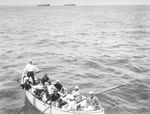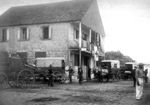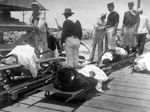The Cost of a Splendid Little War
On the Ground in Cuba and Puerto Rico
 Over 25,000 men took part in the invasion of Cuba. The Army received less than 1,200 casualties before the Spanish surrendered. 932 wounded came from the assault on San Juan Heights alone. A temporary hospital at
Over 25,000 men took part in the invasion of Cuba. The Army received less than 1,200 casualties before the Spanish surrendered. 932 wounded came from the assault on San Juan Heights alone. A temporary hospital at
 Siboney, established to care for only 200 men, was overwhelmed by so many injured that soldiers slept naked on the ground until tents could be set up for them. Fortunately, the Red Cross was able to provide supplies and nurses. For five straight days, doctors treated the wounded. Troops landing in Puerto Rico had a much easier time with only four killed and forty wounded.
Siboney, established to care for only 200 men, was overwhelmed by so many injured that soldiers slept naked on the ground until tents could be set up for them. Fortunately, the Red Cross was able to provide supplies and nurses. For five straight days, doctors treated the wounded. Troops landing in Puerto Rico had a much easier time with only four killed and forty wounded.
While Army doctors were able to handle soldiers' wounds, epidemic disease defeated them. General Shafter, in charge of the Cuban invasion, said that disease was "a thousand times harder to stand up against than the missiles of the enemy." Soldiers mostly suffered from fevers, malaria, yellow fever and typhoid. Yellow fever, which is still incurable, was particularly dreaded because of its high death rate. In the field, doctors were not using laboratories and microscopes to make their diagnosis so the three diseases were frequently
 confused with one another leading to inadequate treatment and quarantines. Investigation after the war revealed that typhoid was the disease infecting over 80% of the troops. Solutions such as burning the town of Siboney to the ground were tried, but eventually the troops were pulled out and returned to the United States where they were quarantined and treated on Long Island, New York.
confused with one another leading to inadequate treatment and quarantines. Investigation after the war revealed that typhoid was the disease infecting over 80% of the troops. Solutions such as burning the town of Siboney to the ground were tried, but eventually the troops were pulled out and returned to the United States where they were quarantined and treated on Long Island, New York.



